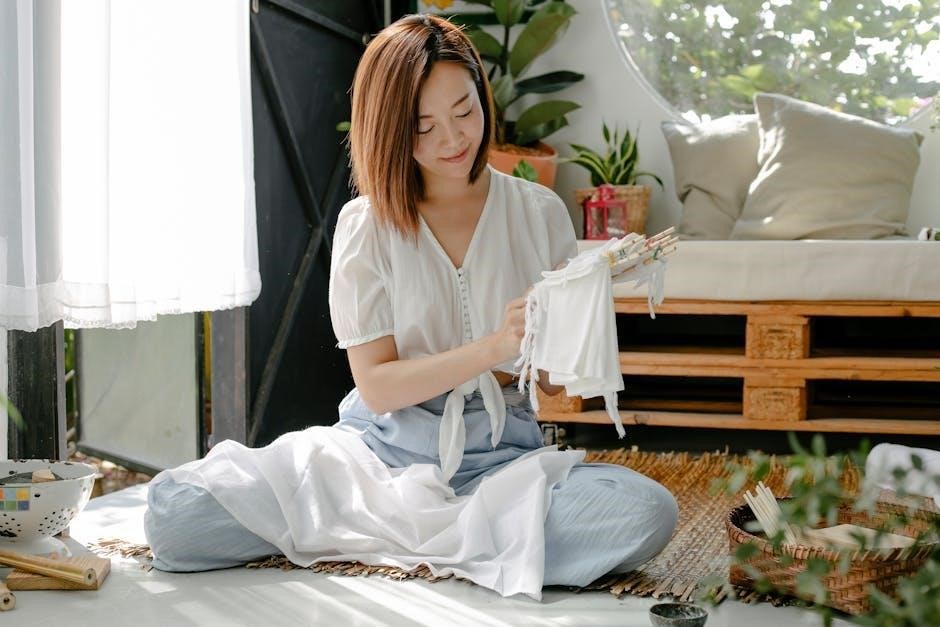Shibori is an ancient Japanese art of fabric manipulation, involving intricate folding techniques to create unique patterns. This traditional craft combines creativity and precision, offering endless design possibilities through resist dyeing methods.
Overview of Shibori and Its History
Shibori, a traditional Japanese textile art, dates back to the Heian period (794–1185 CE). The term “shibori” translates to “to wring or squeeze,” reflecting its core technique of folding, binding, or stitching fabric to resist dye. Originating as a method for creating intricate patterns, Shibori evolved over centuries, influenced by various cultural and technological advancements. Initially used by aristocrats, it later became popular among the working class for creating durable, indigo-dyed clothing. This ancient craft has seen a modern resurgence, blending traditional methods with contemporary designs, making it a timeless art form.
Importance of Folding in Shibori
Folding is the cornerstone of Shibori, determining the final design and pattern on the fabric. By manipulating the fabric through various folds, artists control how dye penetrates, creating unique resist effects. Tighter folds result in less dye absorption, leaving distinct white patterns, while looser folds allow more indigo to seep through. This technique requires precision and creativity, making each piece a blend of planned structure and organic unpredictability. The artistry lies in transforming simple folds into intricate, visually striking designs that showcase the beauty of resist dyeing.
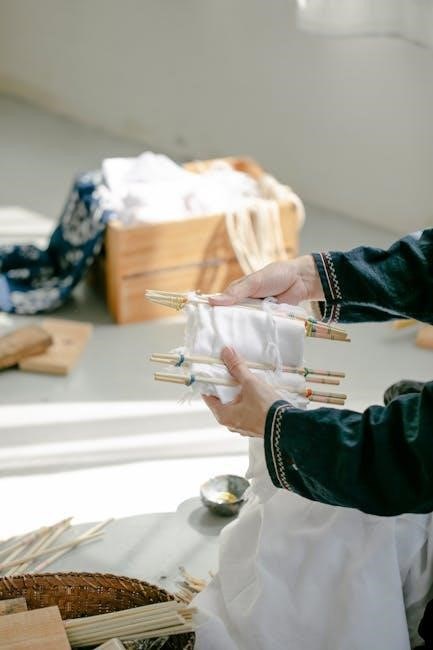
Core Shibori Folding Techniques
Shibori folding techniques involve precise fabric manipulation to create unique patterns. Methods like Itajime, Kanoko, Arashi, and Kumo folding form the foundation of this traditional Japanese resist-dyeing art.
Itajime Folding: Clamping and Resist Techniques
Itajime folding involves clamping fabric between wooden blocks to create intricate patterns. This resist technique prevents dye penetration in specific areas, resulting in unique designs. By folding the fabric into shapes like squares or triangles and securing it tightly, the dye cannot reach the clamped sections. The tighter the fold, the more defined the pattern. This method allows for precise control over the design, making it a popular choice for creating geometric and symmetrical motifs in Shibori art.
Kanoko Folding: Tie-Dye and Stitching Methods
Kanoko folding combines tie-dye and stitching to create unique resist patterns. This technique involves gathering fabric into small bunches and securing them with stitches or thread. The tighter the stitches, the more defined the design. By manipulating the fabric in this way, certain areas resist dye penetration, resulting in intricate, organic patterns. Kanoko is a traditional Japanese method that allows for precise control over the dyeing process, making it a popular choice for achieving detailed and intricate Shibori designs.
Advanced Folding Patterns
Explore intricate techniques like Mandala and Star Fold for symmetrical designs, or Rainbow and Spiral folds for dynamic patterns. These methods expand creative possibilities in Shibori art.
Mandala and Star Fold: Creating Symmetrical Designs
The Mandala fold creates intricate, symmetrical patterns by layering circular folds, while the Star fold achieves geometric precision through angular creases. Both techniques rely on precise folding to resist dye, resulting in striking, mirror-like designs. These folds are ideal for creating visually balanced and sophisticated motifs, making them popular in advanced Shibori projects. By mastering these methods, artists can achieve highly detailed and visually stunning textiles with deep cultural resonance.
Rainbow Fold and Spiral Techniques
The Rainbow Fold involves accordion-pleating fabric diagonally and then folding it into a square or triangle, creating a gradient-like pattern. The Spiral Technique starts with a corner twist, spiraling inward to form a circular design. Both methods create dynamic, multi-dimensional effects. Tight folds resist dye penetration, resulting in vibrant, ombre-like colors. These folds are perfect for achieving fluid, organic patterns that add movement and energy to textiles. They are ideal for creating modern, visually striking designs with a playful twist.
Folding Tools and Materials
Essential tools include wooden or plastic clamps, folding boards, and threads for securing fabric. Natural fabrics like cotton or silk are ideal for shibori techniques.
Essential Tools for Shibori Folding
The right tools are crucial for achieving precise folds and patterns in shibori. Wooden or plastic clamps are commonly used to secure fabric, while folding boards provide a stable surface. Threads or strings are essential for tying and stitching, ensuring tight folds. Scissors and measuring tools help in preparing fabric accurately. Natural fabrics like cotton or silk are ideal for shibori, as they absorb dye effectively. These tools, combined with careful technique, enable the creation of intricate resist patterns that define shibori artistry.
Recommended Fabrics and Dyes
Natural fabrics such as cotton, linen, and silk are ideal for shibori, as they absorb dye effectively. Indigo dye is traditionally used, but natural dyes like pomegranate, turmeric, and indigo are popular for vibrant results. Pre-washing fabric ensures better dye penetration. Tight weaves work best for sharp patterns, while loose weaves allow more dye flow. These materials, combined with careful folding, create the intricate, unique designs shibori is known for, making the process both artistic and rewarding for crafters.
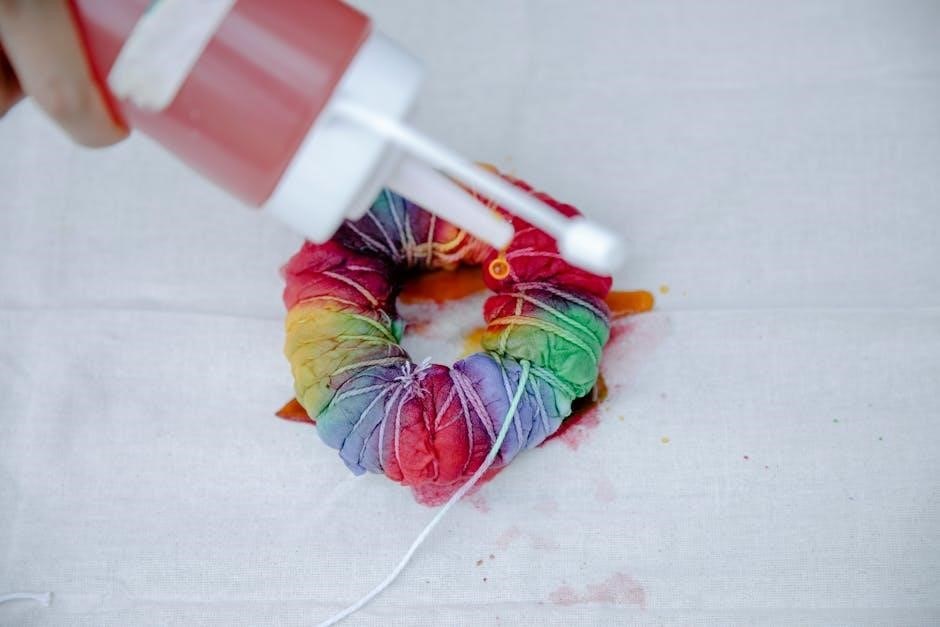
Shibori Folding and Dyeing Process
Shibori combines precise folding with dyeing to create unique patterns. Fabric is folded, secured tightly, and dyed, with folds resisting dye penetration. Looser folds allow more dye, resulting in darker shades, while tighter folds leave white areas. Natural dyes like indigo are often used for vibrant colors. The process involves soaking, dyeing, and setting, with timing affecting color intensity. Understanding this ancient Japanese technique reveals its artistic and cultural depth, offering creative possibilities for textiles.
Resist Technique Basics
Shibori’s resist technique involves manipulating fabric to prevent dye from reaching certain areas. Folding, binding, stitching, or clamping creates resistance, resulting in unique patterns. Tight folds block dye, leaving white spaces, while looser folds allow partial penetration. Natural dyes, like indigo, enhance the process. The technique relies on precise fabric control, ensuring desired designs. This method allows artists to achieve intricate, hand-crafted textiles with deep cultural significance. Understanding the basics of resistance is key to mastering Shibori’s artistic potential.
How Folding Affects Dye Penetration
Folding plays a crucial role in determining dye penetration in Shibori. Tighter folds create resistance, preventing dye from reaching certain areas, resulting in white or lighter zones. Looser folds allow partial dye penetration, creating softer, blended patterns. The accordion fold, for instance, creates linear designs, while layered folds produce complex, multi-tonal effects. The relationship between folding technique and dye penetration is central to Shibori’s artistic expression, enabling precise control over pattern formation and color distribution in the final textile design.
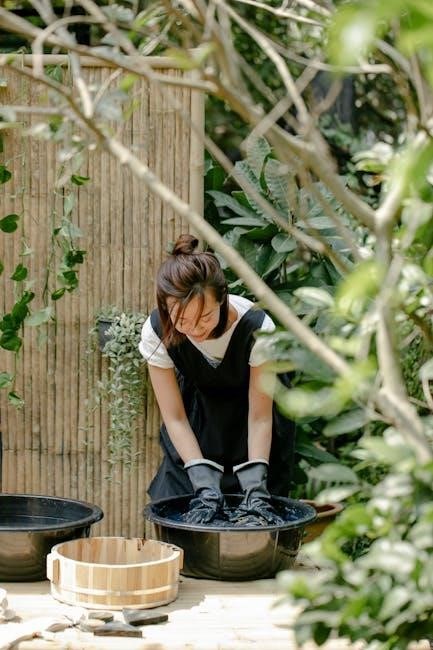
Step-by-Step Folding Instructions
Lay fabric flat, fold into a triangle or square, and secure tightly. Accordion or pleat folds create unique patterns. Tight folds resist dye, while loose folds allow penetration.
Preparation and Initial Folding
Begin by washing and drying fabric to remove finishes. Lay it flat, ensuring no wrinkles. For initial folds, create a triangle or square shape. Accordion pleats or simple folds work well. Secure folds tightly with clips, threads, or rubber bands. Tight folds create sharp resist lines, while loose folds allow more dye penetration. Folded fabric is ready for dyeing. Proper preparation ensures crisp patterns. Follow step-by-step guides for precise folding techniques.
Securing Folds for Dyeing
Securing folds is crucial for achieving clear resist patterns. Use clips, threads, or rubber bands to tightly hold folded fabric. Ensure no gaps where dye can seep. For clamping, place fabric between wooden blocks and secure with wire. Stitching methods involve sewing fabric tightly before dyeing. Properly secured folds prevent unintended dye penetration. Check folds before dyeing to ensure they are tight and even. This step ensures crisp, well-defined patterns in the final design.
Creating Unique Patterns
Shibori’s uniqueness lies in combining multiple folds and layering techniques, allowing for intricate, one-of-a-kind patterns through creative fabric manipulation.
Combining Multiple Folds
Combining multiple folds in Shibori allows for intricate, layered designs. By mixing techniques like accordion, spiral, and mandala folds, you can achieve complex patterns that showcase texture and depth. Experimenting with overlapping folds and varying tightness creates unique resist effects. Secure folds with threads or clamps to ensure consistent dye resistance. This method enables the creation of multi-dimensional designs, blending organic and structured elements for stunning visual results. Practice and patience refine the art of layering folds to achieve exceptional Shibori patterns.
Layering Techniques for Complex Designs
Layering techniques in Shibori involve stacking multiple folds to create intricate, multi-dimensional patterns. By combining methods like accordion folds and spiral folds, you can achieve complex designs. Secure each layer with threads or clamps to maintain structural integrity during dyeing. The tighter the folds, the more pronounced the resist effect will be, resulting in unique, layered patterns. This approach allows for a blend of structured and organic elements, creating visually striking Shibori designs that showcase depth and creativity.
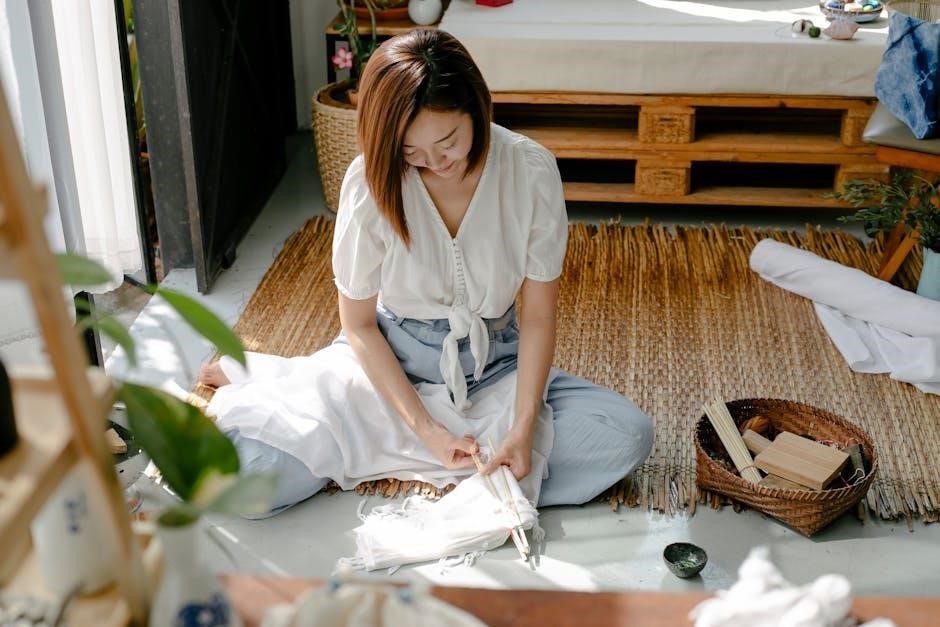
Tips and Tricks
Ensure tight, even folds for crisp patterns. Experiment with fold variations to achieve unique designs. Secure folds properly to prevent dye leakage for clear resist effects.
Common Mistakes to Avoid
When practicing shibori folding, common mistakes include uneven folds, inconsistent pressure, and improper securing of fabric. Loose folds may result in dye leakage, reducing resist effectiveness. Over-tightening stitches can damage fabric or create unwanted creases. Ensure fabric is evenly folded and secured tightly to achieve crisp, clear patterns. Avoid using overly thick fabrics that resist dye penetration. Proper preparation and attention to detail are key to achieving professional results in shibori techniques.
Advanced Tips for Professional Results
To achieve professional-grade shibori patterns, consider layering folds and combining techniques for intricate designs. Experiment with natural dyes and premium fabrics for richer hues. Ensure folds are tightly secured to prevent dye leakage. Post-dyeing, gently rinse and dry fabrics to preserve patterns. For symmetrical designs, use precise measurements and tools. Practice consistency in folding to master complex resist techniques. Advanced tools like wooden clamps can enhance precision. Regularly test fabrics and dyes to refine results, ensuring each piece is unique and of high quality.
Shibori folding techniques offer a timeless blend of artistry and unpredictability, creating unique, organic designs. This ancient craft continues to inspire, blending tradition with modern creativity seamlessly.
Final Thoughts on Shibori Folding
Shibori folding is a captivating art form that combines precision and creativity, offering endless possibilities for unique textile designs. By manipulating fabric through various folds and bindings, artists can achieve intricate patterns that blend tradition with modern aesthetics. This ancient technique not only preserves cultural heritage but also inspires contemporary designers to explore new visual expressions. The process encourages experimentation, making it a timeless craft that continues to evolve and inspire creativity worldwide.
Encouragement to Experiment
Embrace the journey of shibori folding by experimenting with diverse techniques and materials. Each fold and bind offers a unique opportunity to create something extraordinary. Don’t hesitate to explore unconventional methods or combine traditional styles with modern twists. Shibori’s beauty lies in its unpredictability, so celebrate the unique results that emerge from your creative process. Remember, the art of shibori is as much about the journey as it is about the final design—so dive in, explore, and let your imagination unfold!
